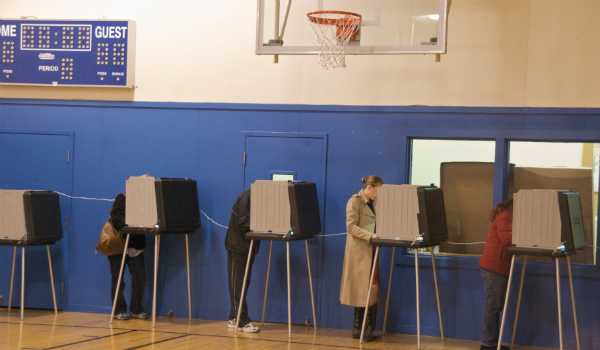
Polling place in San Francisco, CA. (Photo Credit: Steve Rhodes/Flickr)
It’s actually rather ironic. Among reporters and others who follow politics and voting, the impact of California’s top-two primary is getting a lot of “run.”
That energy might be better spent on talking about how to motivate more Californians to vote. More on that in a moment. First, let’s talk about top-two.
Over the weekend the San Francisco Chronicle ran a story on the impacts of the top-two primary in California, noting that the new primary system resulted in creating a number of competitive general election races for seats that wouldn’t have been hotly contested under the previous model.
California Forward Action Fund supported the voter-approved change in 2010.
“The reality is that it’s late June and the election is not yet over,” Jim Mayer, president and CEO of California Forward told the Chronicle. “In the past, people in the capital would be mapping out who’s going to be there in January,” he said. “Now there’s a lot of uncertainty, and that’s a good thing.”
Not everyone agrees. The L.A. Times ran an op-ed this week criticizing the state’s top-two primary system.
It’s healthy that, three weeks after June 3, we are still talking about the election, although not much of that talk is around the bigger issue: how to improve record-low turnout.
Last week, California Forward asked its email subscribers whether or not they are concerned about declining voter participation. Like many Californians, they are concerned by low turnout but aren’t sure how to fix the problem. Here’s a story on what they said.
That brings me to a conversation I had over the weekend with three Millennial San Diegans–an attorney, a regional sales executive and a restaurant owner.
Not one of them voted in the primary—their general consensus was that their vote didn’t matter and the election, lacking heated contests or controversial issues, failed to generate any enthusiasm.
All three vote in Presidential elections and all cast ballots in the San Diego mayoral recall election, yet they couldn’t be bothered to vote in this year’s statewide primary.
That’s bothersome. Now, let’s share a little perspective.
This is not just a California problem. In fact, California’s voter turnout in this year’s primary (about 25 percent) was nearly double the recent Virginia congressional primary (13 percent) that saw Republican House Majority Leader Eric Cantor go down to defeat.
California actually has one of the highest primary election turnout rates in the country. And yet that still meant nearly 20 million eligible Californians joined those three San Diegans on June 3 and sat out the primary election.
That’s why we need to keep the conversation going, not just about top-two, but about how to encourage more people to cast their ballot in every election.

